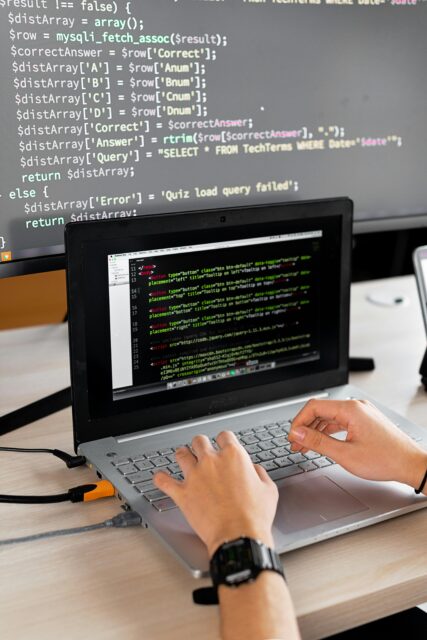Programming is a task and an exciting career path that allows people to develop unique and functional software solutions. Writing code, however, involves more than just making things work; it is also about producing code that is clean, efficient, and maintainable. To accomplish this, software developers or engineers should become familiar with a set of fundamental software programming techniques. These techniques serve as guiding lights for developers, allowing them to build code that is strong, scalable, and easy to understand. This essay will look at 10 fundamental software programming techniques that any software developer should understand. Understanding and using these notions in your coding methods will allow you to produce code that is not only functional but also clean and manageable.
Types of Programming Techniques with Examples
1. Imperative Programming
Imperative programming consists of sets of explicit instructions that are delivered to the computer and executed in a specific order. It’s dubbed “imperative” because programmers specify exactly what the machine should accomplish. Imperative programming focuses on explaining how a program works step by step. Say you want to make a cake. Your imperative program to accomplish this could look like this:
- Pour flour into a bowl.
- Pour a couple of eggs into the same bowl.
- Pour some milk into the same bowl.
- Mix the ingredients.
- Pour the mix into a mold.
- Cook for 35 minutes.
Using an actual code example, suppose we want to filter an array of numbers to keep only the elements greater than 5. The imperative code could look like this:
const nums = [1, 4, 3, 6, 7, 8, 9, 2]
const result = []
for (let i = 0; i < nums.length; i++) {
if (nums[i] > 5) result.push(nums[i])
}
console.log(result) // Output: [ 6, 7, 8, 9 ]
2. Procedural Programming
Procedural programming is a variant of imperative programming that incorporates functions (sometimes known as “procedures” or “subroutines”). In procedural programming, the user is encouraged to break down program execution into functions to improve modularity and structure. Using our cake example, procedural programming could look like this:
function pourIngredients() {
– Pour flour in a bowl
– Pour a couple eggs in the same bowl
– Pour some milk in the same bowl
}
function mixAndTransferToMold() {
– Mix the ingredients
– Pour the mix in a mold
}
function cookAndLetChill() {
– Cook for 35 minutes
– Let chill
}
pourIngredients()
mixAndTransferToMold()
cookAndLetChill()
3. Functional Programming
Functional programming extends the concept of functions. Functional programming treats functions as first-class citizens, which means they can be assigned to variables, supplied as arguments, and returned by other functions.
Another important topic is the notion of pure functions. A pure function generates its output entirely from its inputs. And the same input will always provide the same output. Furthermore, it has no side effects (any modification beyond the function’s context).
With these notions in mind, functional programming encourages programs that are mostly composed of functions. It further argues that code modularity and the lack of side effects make it easier to identify and distinguish tasks within a codebase. This therefore improves the code maintainability.
Returning to the array filtering example, we can see that under the imperative paradigm, we may use an external variable to store the function’s result, which might be called a side effect.
const nums = [1,4,3,6,7,8,9,2]
const result = [] // External variable
for (let i = 0; i < nums.length; i++) {
if (nums[i] > 5) result.push(nums[i])
}
console.log(result) // Output: [ 6, 7, 8, 9 ]
To transform this into functional programming, we could do it like this:
const nums = [1,4,3,6,7,8,9,2]
function filterNums() {
const result = [] // Internal variable
for (let i = 0; i < nums.length; i++) {
if (nums[i] > 5) result.push(nums[i])
}
return result
}
console.log(filterNums()) // Output: [ 6, 7, 8, 9 ]
4. Declarative Programming
Declarative programming is all about hiding complexity and making programming languages more similar to human language and reasoning. It is the polar opposite of imperative programming in that the programmer does not specify how the machine should do the work, but rather what outcome is required. This will become a lot more clear with an example. Following the same array filtering narrative, a declarative method may be:
const nums = [1, 4, 3, 6, 7, 8, 9, 2]
console.log(nums.filter(num => num > 5)) // Output: [ 6, 7, 8, 9 ]
Notice that with the filter function, we are not explicitly instructing the computer to loop over the array or save the values in a separate array. We just specify what we want (“filter”) and the condition to be met (“num > 5”).
What’s wonderful about this is that it’s easier to read and understand, and it’s often quicker to write. The filter, map, reduce, and sort methods in JavaScript are excellent instances of declarative coding.
Another notable example is current JS frameworks/libraries such as React. Take this code as an example:
React uses JSX syntax, which combines HTML and JS, making app development easier and faster. However, that is not what browsers read and execute. React code is then transpiled into ordinary HTML and JS, which is what browsers use in practice.
JSX is declarative in the sense that it aims to provide developers with a more user-friendly and efficient interface.
One crucial aspect of declarative programming to keep in mind is that the computer will still process this information as imperative code.
5. Object-Oriented Programming
One of the most widely used programming paradigms is object-oriented programming (OOP). The core idea of OOP is to divide concerns into entities that are coded as objects. Each entity will group a specific set of information (properties) and actions (methods) that it is capable of performing.
OOP makes extensive use of classes. Objects formed from a class are referred to as instances. Following our pseudo-code cooking example, suppose we have a chief cook (named Frank) and an assistant cook (called Anthony), both of whom will have certain roles during the baking process. If we adopted OOP, our software could look like this.
// Create the two classes corresponding to each entity
class Cook {
constructor constructor (name) {
this.name = name
}
mixAndBake() {
– Mix the ingredients
– Pour the mix in a mold
– Cook for 35 minutes
}
}
class AssistantCook {
constructor (name) {
this.name = name
}
pourIngredients() {
– Pour flour in a bowl
– Pour a couple eggs in the same bowl
– Pour some milk in the same bowl
}
chillTheCake() {
– Let chill
}
}
// Instantiate an object from each class
const Frank = new Cook(‘Frank’)
const Anthony = new AssistantCook(‘Anthony’)
// Call the corresponding methods from each instance
Anthony.pourIngredients()
Frank.mixAndBake()
Anthony.chillTheCake()
Software Programming Techniques List

1. Internalize Your Code
As a developer, you must first see how your code will look before you begin coding. If feasible, begin by writing the code on a piece of paper. Once you comprehend the concept underlying the code, the algorithm and the entire compiler process will make more sense. The easiest strategy to tackle a complex problem or create an algorithm to handle any complex problem is to divide it into sub-problems and then try to develop a solution for each.
2. Simplify your code
It is a recommended practice for developers to keep their code as simple and readable as possible. By keeping things simple, you may get the desired objectives with a few lines of code, produce higher-quality code, solve problems faster, work successfully in developer groups, and have a more adaptable code base, among other benefits.
3. Comments
Although correctly commenting source code has no effect at runtime, it is useful for a developer who must maintain a particularly complex or burdensome piece of software. Including comments in your code makes updating, debugging, analyzing, and other post-programming tasks simpler and more efficient. Furthermore, if you operate in a team, including comments in the code makes it easier for the other members to grasp.
4. DRY Principle
DRY stands for Do Not Repeat Yourself. Also known as DIE (Duplicate Is Evil). The principle goes as follows: “Every piece of knowledge must have a single, unambiguous, authoritative representation within a system.” This is the usage of functions, classes, and instances to prevent having to retype previously written code. This fundamental idea allows developers to avoid duplication, resulting in considerably cleaner code than a programmer who employs excessive repetition. Optimizing code is frequently what distinguishes a brilliant coder from an average one.
5. Consistent indentation
Indenting your code is akin to arranging items in your space. Assume you wake up one morning and there is no consistency in the arrangement of items in your room. Your shoe is in your bathtub, your toothbrush in your rearranged couch, your shirt on top of the refrigerator, and so on. The indentation in the code is similar to the organization that you require in your room or anywhere else in the actual world. Indenting your code makes it easier to read and find what you’re looking for.
6. Naming convention
A correct naming convention is critical in code since it allows for future adjustments and updates to be made easily. Having inappropriate or contradictory names for your pages, variables, functions, or arrays can only cause problems in the future. As a result, name elements based on what they are and make it a habit to follow a convention throughout your codebase. Avoid using names that expose the underlying implementation. This indicates that a name should express “what” rather than “how.” You can use GetNextStudent() instead of GetNextArrayElement().
7. Capitalize SQL Special Words
Database interaction is an important aspect of most online applications. When developing raw SQL queries, try to keep them as readable as possible.
Even though SQL special words and function names are case insensitive, they are commonly capitalized to distinguish them from table and column names.
SELECT ‘id’, ‘username’ FROM ‘user’ ;
8. Learn New Programming Skills
Approximately 98% of expert developers or coders began with Hello World! Learning and applying new programming skills is the only way to become an expert. There is a wealth of resources available in the shape of videos, forums, blogs, and online courses. Accessing these internet resources has become much easier thanks to Google. Make excellent use of them and continue coding; the more you code, the better you will become.
9. Reduce the use of copy and paste
As a developer, you may occasionally get stuck and seek assistance from the internet or another source. As far as feasible, alter the source codes you obtain from those sources. Use the assistance you are receiving to your advantage and attempt to optimize the code that you have. There is so much delight in writing code and solving problems on your own.
10. Test your application
Most consumers stop using a software application or service because the first time they opened it, all they saw was a rectangular box on the screen since the browser was unable to show the requested content or an unhandled exception occurred. To avoid these scenarios, as a developer, your final task should be to check how your website appears on various devices and make the necessary changes.
Test your desktop application on several operating systems and frameworks. The adage “Don’t judge a book by its cover” does not apply to programming languages because the better your display looks, the more recognition your work receives.
